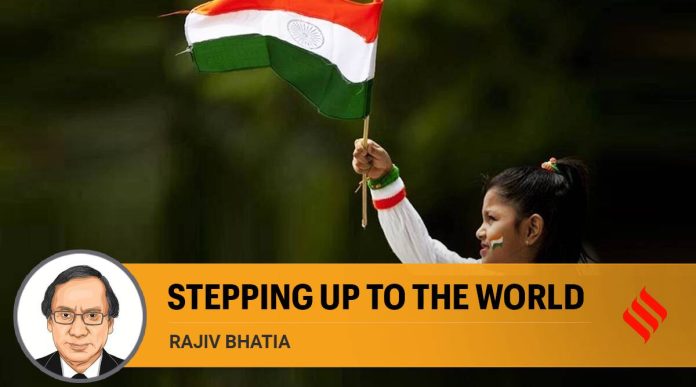A critical assessment of India’s foreign policy during 1947–2022 should begin with the changing perceptions of this nation, internally and internationally. A young state with an uninterrupted 5,000-year-old civilisation, India began its political journey with ideals of equity stemming from its unique freedom struggle led by Mahatma Gandhi and Jawaharlal Nehru’s insistence that the country’s independence would be incomplete without the liberation of Asia and Africa. The journey was also marked by the pain of Partition and the trauma of the war with Pakistan over Jammu and Kashmir. From an economy that faced the challenge of feeding its population until the 1960s, India has emerged as the fifth largest economy.
India’s ties with countries across regions — in the South Pacific, through Southeast and South Asia, in other parts of Asia, Europe, the Indian Ocean region, Africa, North America and Latin America — show it to be an aspiring, as well as a major player on the world stage. A leading member of the UN, an oft-invitee to the G7, a founding member of the BRICS, and a pivotal part of the G20 now ready to take over as its chair, India has become a major stakeholder in the comity of nations.
National interest drives foreign policy, but more is at stake here: It is realpolitik plus. The policy is anchored in a nuanced balancing of interests and values. National security remains the key driver. In addition to it is the belief that external relationships accelerate the country’s economic progress. Other motivations include the desire to enhance the nation’s standing externally and the impulse to do good for the world — India did not hesitate to share Covid medicines and vaccines with over 90 countries within a month of their launch.
In the past, South Block accorded the highest priority to India’s immediate neighbours, given the history of conflicts with Pakistan and China, the liberation of Bangladesh and the military interventions in Sri Lanka and Maldives. In the post-Cold War period, India has moved more time and resources to careful nurturing of relations with the major powers — the US, EU, especially France and Germany, the UK, Japan, Russia and China. Though the doors of permanent membership of the UN Security Council remain shut, India’s enhanced GDP and its IT prowess have positioned it in parallel with the apex group of leaders. At the height of the Non-Aligned Movement and G77, India was the leader of the “have-nots”. By enjoying proximity with the West and demonstrating the capability to cooperate and communicate with the “other” side — Russia, the time-tested partner, and China, the principal adversary but also a consequential neighbour — India now acts as a balancer and leader.
The neighbours have not been ignored. Equations with Bhutan, Bangladesh and Maldives are excellent. The tide that ran against India in its ties with Afghanistan, Nepal and Sri Lanka in recent years seems to have turned since the Covid-19 pandemic. A fine balancing act between the military government and its opponents in Myanmar is underway. More needs to be achieved in regional cooperation and integration. Having concluded that SAARC’s shelf life is over, New Delhi accords priority to BIMSTEC, but this train runs too slow.
The Indo-Pacific has emerged as a principal theatre for Indian diplomacy. The increased emphasis on cooperation with Japan, Australia and the US has turned the Quad into a strong forum. The combined impact of formations such as AUKUS (Australia, the UK and US), the Indo-Pacific Economic Framework, Partners in the Blue Pacific and India’s continuing focus on ASEAN, despite the setback of its exit from RCEP, is a determined pushback to China.
Across the Western shores, prospects have improved with the establishment of I2U2 (India, Israel, U.S. UAE) — this became possible due to the progress in India-UAE, India-Israel and UAE-Israel relations. The Indian Ocean region is witnessing an active US-China contestation and China-India competition. Positioning Africa’s eastern and southern flanks as a part of the Indo-Pacific could enable India to craft a series of initiatives to strengthen cooperation in maritime activity, economic development, and the blue economy.
Among the 14 prime ministers, five have left a strong imprint on foreign policy: Jawaharlal Nehru, Indira Gandhi, Narasimha Rao, Atal Bihari Vajpayee and Narendra Modi. The Ministry of External Affairs has become a more professional machine. Foreign policy making is aided by academia, think tanks, civil society and media more than ever before.
The increasing engagement of the wider public — especially the youth and business community — with foreign policy issues reflects the maturity and sophistication of Indian democracy. These trends must deepen and India’s G20 Presidency provides a perfect opportunity and beginning for the next anniversary era.
Rajiv Bhatia is Distinguished Fellow, Gateway House and a former ambassador























